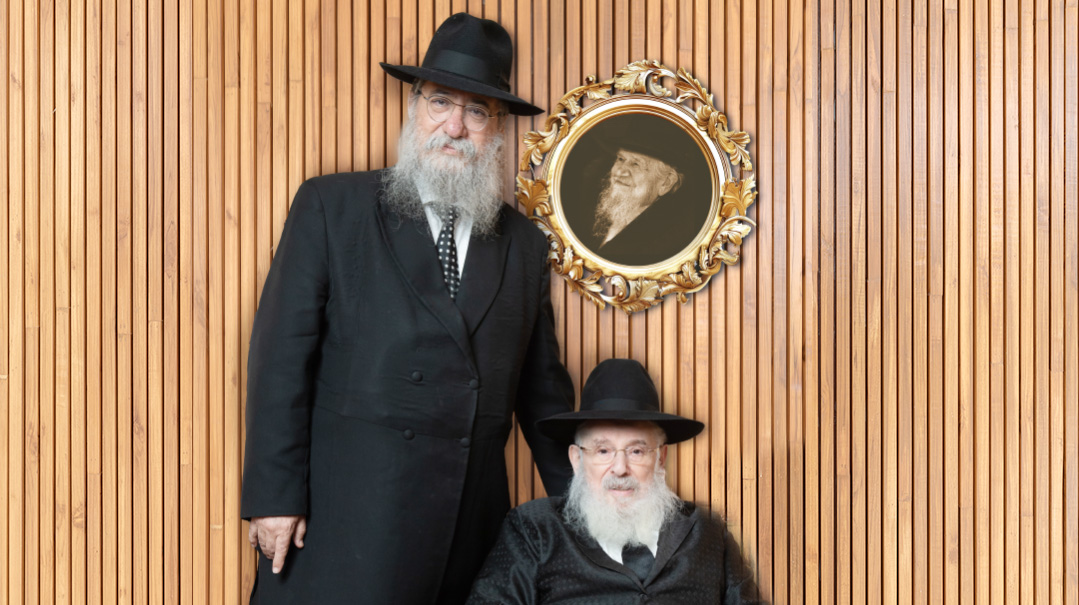Strapped Together
| March 5, 2024What if those old pairs of tefillin collecting dust could find a new home and give nachas to the neshamah at the same time?
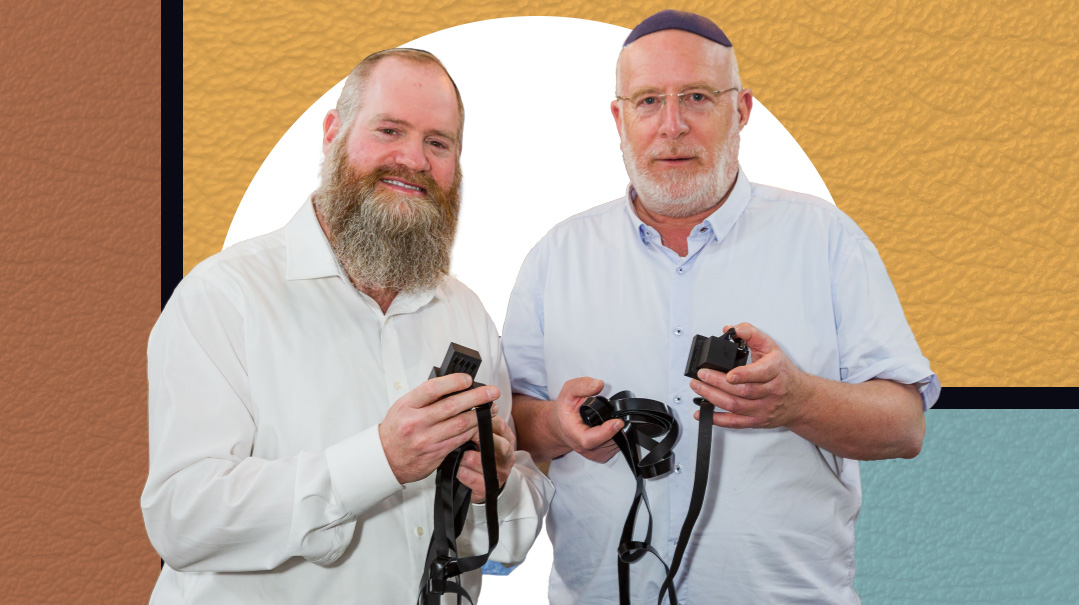
Photos: Elchanan Kotler
One person has his righteous grandfather’s tefillin sitting in a closet, while another fellow has decided he wants to commit to wearing phylacteries every day, but can’t afford a new pair. In Israel these days, where a spiritual awakening has put the demand for tefillin through the roof, what if those old pairs collecting dust could find a new home and give nachas to the neshamah at the same time?
IT was known as the battle of Tel Saki, one of the most difficult battles of the 1973 Yom Kippur War, and one that by a sheer miracle helped prevent the Golan Heights from being captured by Syria. The price was high, though, as the burning, smoking tank had sustained a direct hit from a Syrian anti-tank missile, and both inside and out were the bodies of Jewish soldiers who had lost their lives. Yet the rescue force found a small ray of consolation, a light in the heart of the inferno — a pair of tefillin had survived intact.
Fast forward nearly 44 years, to July of 2017. A young officer named David Golovensitz a”h — a former talmid of the Bnei Tzvi yeshivah in Beit El and of Yeshivat Shavei Chevron — was killed during a military operation in Chevron. David was a natural leader, and while still just a teenager, he established several chesed organizations, including food distributions for needy families and a “draft” of yeshivah bochurim to bring joy to weddings of new immigrants and others without family.
“Right after the shivah, my wife told me, ‘Shimon, go and give a pair of tefillin to a soldier in David’s memory,’ ” says Shimon Golovensitz of Efrat, former director of Mayanei Hayeshuah Medical Center and a communal projects innovator. “So I called someone I know who deals in tefillin, asked what a pair costs, he told me $500. Now, just a few hours before our son was killed, I had returned from the US where I’d escorted a planeload of olim, so I stuck hand in my pocket and pulled out my remaining US cash — exactly $500.
“That was for the first pair of tefillin, and somehow, it just snowballed. Now we’re sponsoring over 1,000 pairs of tefillin for soldiers every year. All the officers know me by now, so whoever wants tefillin can get in touch with me. A few weeks ago, I got a message from a soldier who’d never put on tefillin before, and one of my delivery boys — young fellows who go from base to base on their motorcycles — happened to be two minutes from his base, and by the time I hung up he’d already sent me a clip of him with the tefillin.”
Who are the soldiers that have been contacting Golovensitz over the past six-plus years? He says it could be a soldier from a poor family who might have put on his father’s or uncle’s tefillin until the army but never spent the money on a pair of his own, a soldier from the former Soviet Union who never had a bar mitzvah, or a lone soldier whose family lives abroad and isn’t religious.
“I get about a hundred requests a day,” Golovensitz says. “They text me things like, ‘I never wore tefillin before and never thought I would, but now I want to, so please send me. I don’t want to go into battle without them.”
Soon, after he began the initiative, Golovensitz got the shock of his life, when a middle-aged woman knocked on his door and handed him a pair of tefillin. “Here,” she said, “I want your organization to have them. These are the tefillin that belonged to my brother, who fell in Tel Saki in the Yom Kippur War. There was nothing left of the tank, but somehow his tefillin and the bag weren’t incinerated. The army brought the package to our home, and it’s been sitting for decades in our breakfront. Now I want you to give them to another soldier.”
“The next person to contact me was a lone soldier from the US,” Reb Shimon relates. “I felt like it was the closing of a circle, that the tefillin of this chayal who fell 50 years ago should go to this soldier who came all by himself to fight for the Jewish people.”
Soon Reb Shimon had given out a hundred pairs, and then a thousand. He says he’s given out over ten thousand pairs of tefillin since he began. But where does he obtain so many pairs of tefillin?
“At first, I got a donation of a few hundred pairs from an Australian entrepreneur who was personally acquainted with David from his projects. Afterward, I appealed to the general public, telling people, ‘If you have tefillin that no one is using, give them to me. There are people waiting for them.’ ”
Within minutes of the notification, Golovensitz received dozens of messages from people who had tefillin to give over — but the problem was that most of those pairs, after sitting unused for so long, were pasul. Who else would have extra pairs of tefillin just waiting to be used?
“Then I had this brainstorm — maybe I should contact El Al. I figured they probably have many pairs of tefillin that had been forgotten over the years,” he says. That proved to be a good move, and then Golovensitz turned to other channels — Israel Railways, the Israel Airports Authority, Egged — these and others were happy to give them tefillin that they had amassed from passengers who had forgotten them and never claimed them.
“When the one-year mark of David’s passing approached, we considered stopping the tefillin distribution. We had given out more than 1,000 pairs that year, and we believed we had done something special for the aliyah of his neshamah,” Reb Shimon relates. “But then, on the yahrtzeit, a friend sent me a picture of a copy of David’s bar mitzvah speech. At the time I’d printed a copy of the speech for all the guests, and for some reason, this friend had tucked the copy into a sefer once he got home and forgot about it.”
On the day of the yahrtzeit, his friend randomly opened that particular sefer and found the paper with the speech, which he sent back to Golovensitz.
“I started reading the speech and my heart began to pound,” he recalls. “David explained in his derashah the importance of putting on tefillin and the great virtues that it contains.” For him the sign was clear — the initiative would continue. “I felt like David had come to me and said: ‘Abba, you’re on the right track. Keep going!’ ”
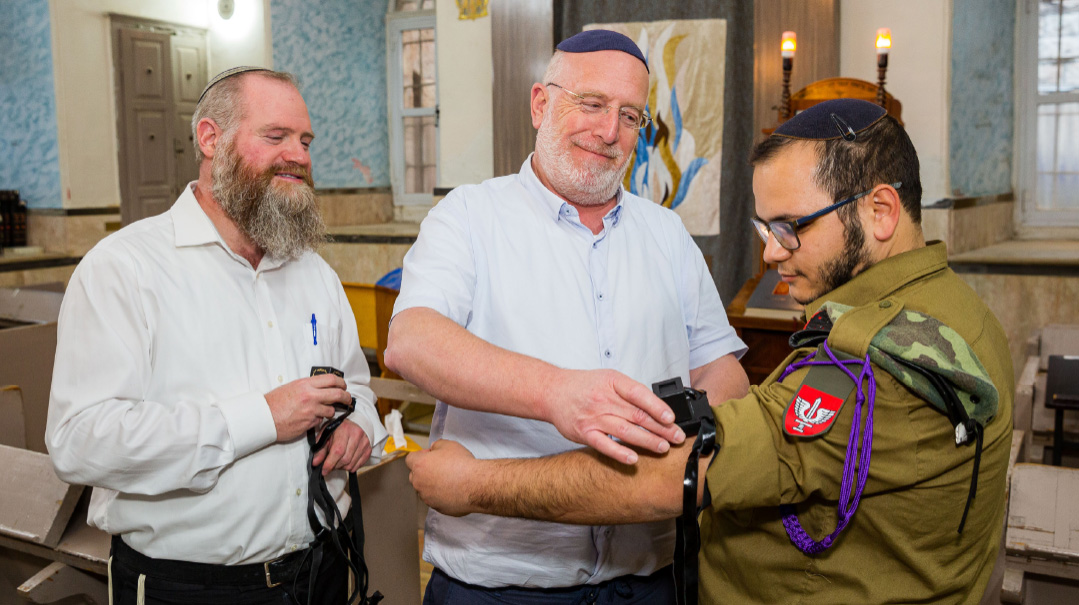
Until the Gaza war broke out, maggid shiur, outreach activist and tefillin “shadchan” Rabbi Amichai Eyal had never crossed paths with Shimon Golovensitz, even though both of them have spent the last few years in essentially the same chesed business: giving Am Yisrael the zechus of fulfilling the mitzvah of tefillin.
But since Simchas Torah, when even the most secular Jews of Eretz Yisrael seem to have been swept up on a wave of desire for tradition and an interest in drawing closer to their Source, the two have joined forces. Between Reb Shimon’s initiative to provide tefillin for every soldier who contacts him, and Rabbi Eyal’s matching project between people who have old tefillin and those who want to start donning them, thousands of Jewish men have begun strapping themselves into a higher spiritual frequency.
Rabbi Eyal has been active in the teshuvah moment for decades. Concurrent to serving as a maggid shiur in the yeshivah in Beit El, he began giving shiurim to a small group of young men who were interested in furthering their Jewish knowledge.
It began about 20 years ago with a shiur in a pub in the trendy Nachalat Shivah neighborhood in Jerusalem, where he taught a bit about the parshah and a bit of Mesillas Yesharim, and slowly it grew. Today he serves as executive director of the popular Nehora outreach center in Ramat Gan, and he heads another organization as well — Kesher Shel Tefillin, a sort of matching service between those who have extra tefillin and those who want them.
“At the time, I began to get requests from those young people who had grown closer to their heritage through the shiurim. They took upon themselves the mitzvah of tefillin, but they didn’t actually own a pair. They asked me if I could help them get kosher tefillin,” Rabbi Eyal relates. “In a religious family, every father knows that when his son reaches bar mitzvah, he will buy him a pair of mehudar tefillin. But among new baalei teshuvah, it’s very different. They don’t always have the option of investing such large sums of money to buy tefillin, and will therefore often forego the mitzvah. I asked myself: How do I get pairs of tefillin for them?”
And then he met an old friend who had become a tefillin dealer, and this friend had an idea: “Many people come to me to buy new tefillin, and they leave the old ones with me. Let’s have them checked, let’s fix what needs fixing, and then we’ll pass them on to those who want to start wearing them.”
That’s how Amichai Eyal’s “Kesher Shel Tefillin” came into existence, but it took on wings of its own.
“There are so many people who have been aroused to put on tefillin, and on the other hand, there are a lot of pairs of tefillin lying around in closets not being used, collecting dust — they could be from a grandfather or uncle who passed away, or someone who bought a new pair,” Rabbi Eyal explains. “Today, people who have extra tefillin that are not being used contact us, we come to collect them, take them to be checked, and then refurbish them and prepare them like new.
And so, from a small initiative that began from a localized need of his students in that shiur in the center of Jerusalem’s nightlife, Reb Amichai has become an address for thousands of Jews who have turned to him with a request for kosher tefillin.
The “Kesher Shel Tefillin” turns out to be a personal kesher as well. “With every person who contacts me, I meet him in person, creating a personal bond. I meet him because I want to make sure the tefillin I’m giving him will actually be used, and not go from sitting in some other closet to sitting in his closet.
“I’m not into miracle stories,” Rabbi Eyal continues, “but just recently a fellow from Maaleh Adumim requested a pair of mehudar tefillin, so of course we brought a pair to his house. This young man told me how, when his mother became sick with cancer, he took on himself to put on tefillin every day for his mother’s recovery. The second day, he got a call from the professor who’s caring for his mother, telling him that the PET scan came out clean. He started dancing around the house.
“These are very complex times,” he continues. “On one hand, there are tremendous tragedies, mind-boggling atrocities, and on the other, there is a tremendous light, people are waking up to shemirat hamitzvot — they don’t even know why, they just feel something burning inside, some unexplained awakening. There are what I call “emunah” germs floating around in the air and “contaminating” people. And in very simple terms, the tefillin are what tangibly bind Hashem to the heart and to the mind, so the very center of a person’s being is now being connected to HaKadosh Baruch Hu.”
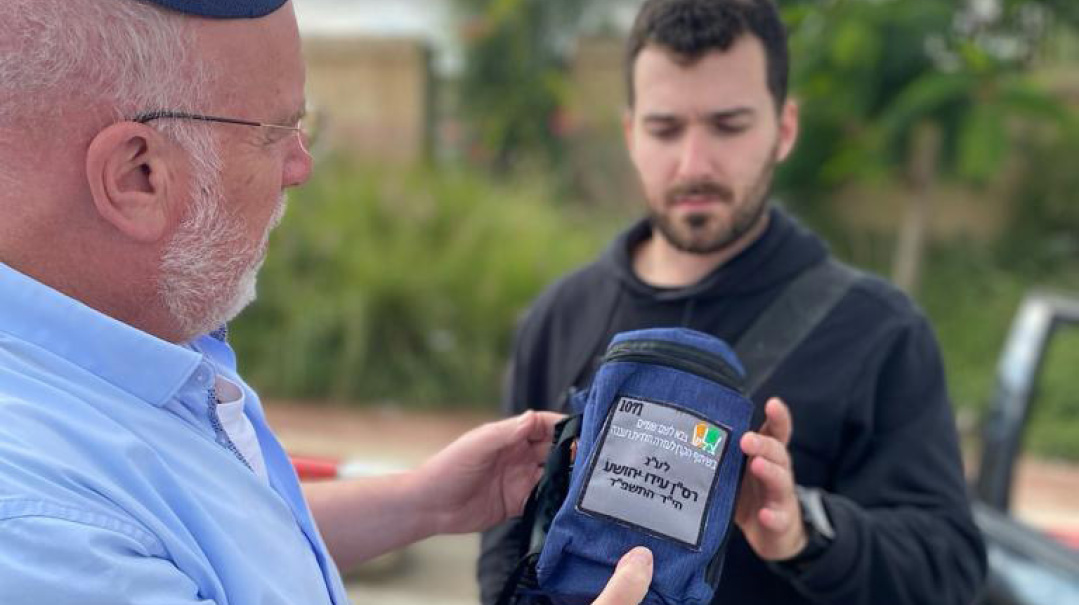
Rabbi Eyal attributes his passion for the mitzvah of tefillin, and really every mitzvah that can help another Jew, to the famed Chabad-Meah Shearim mashpia Rav Moshe Weber ztz”l.
“I was a young bochur when Rav Weber came to Yeshivat Beit El to hold a hitvaadut at the invitation of several talmidim. At the time, I said to myself, ‘What do I have to do with chassidut?’ But after finishing my learning seder, I went to the room where the hitvaadut was taking place. I wanted to see what was going on there.
“Rav Moshe was singing the famous niggun, ‘Tzamah Lecha Nafshi,’ and my soul was captivated by both the niggun and his noble demeanor. It wasn’t long before I became his chassid.
“Reb Moshe infused us with so much ahavat Yisrael, that anyone who was in his proximity was touched by it. I would say he was the source for all my kiruv involvement, and is still my inspiration 24 years after his passing.”
While Shimon Golovensitz deals exclusively with soldiers, Reb Amichai makes his tefillin shidduchim with the broader population.
“I’ve established a pretty broad network, and that’s how a circle of kiruv and giving has been formed, which grows stronger by the day.”
But, he admits, it sounds easier than it actually is.
“People find it very difficult to part with tefillin that have sentimental value,” Rabbi Eyal explains. “No one wants to part with tefillin that belonged to a deceased father or grandfather, even if they’re no longer being used. It’s very hard for relatives to give them over to someone they don’t even know. But you know, if you’d ask the deceased relative, the owner of the tefillin, he would surely want those tefillin given over to another Jew whose soul is yearning to merit this mitzvah.”
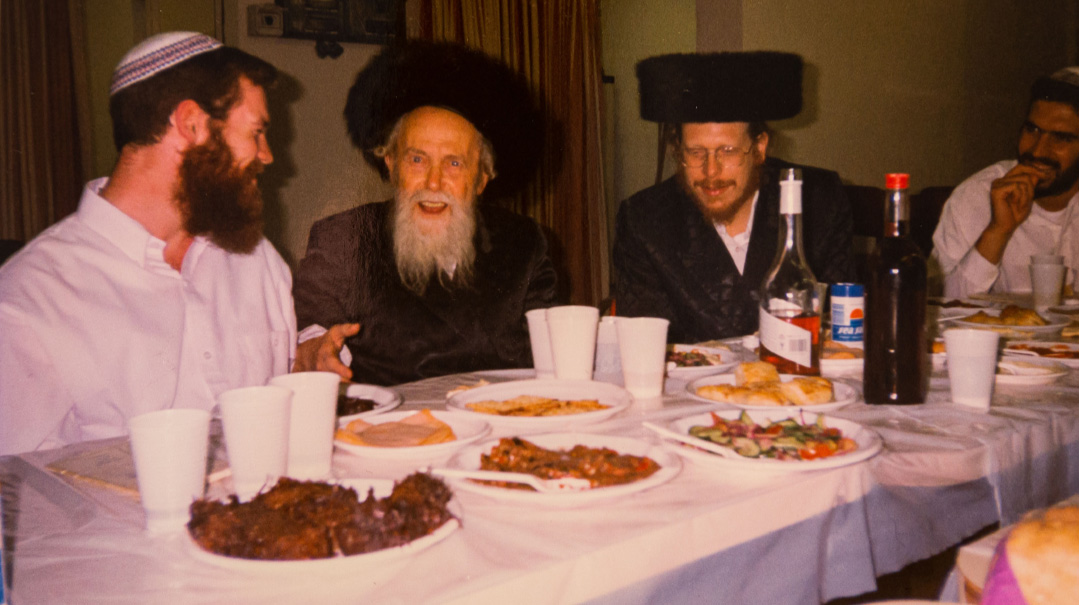
The day after Simchas Torah, Shimon Golovesitz’s phone wouldn’t let up — there were hundreds of messages from soldiers and others, whose hearts had awoken. But how would he keep up with this new, escalated level of demand, even with his dedicated team of motorcyclists who volunteered to drop off tefillin at military installations around the country?
“When the wave of requests began at the beginning of the war, I panicked,” Golovensitz says. “I didn’t know how I could provide so many pairs of tefillin. But then I met my new friend, Reb Amichai, and together we’ve succeeded beyond anything we could have imagined.”
It turns out that their connection was closer than either had imagined. Rabbi Eyal knew David Golovensitz well, from the years when he learned in the yeshivah in Beit El. Amazed at this special connection, they set out on a joint path to give Am Yisrael the extra zechus and protection during these days of upheaval. In their divide-and-conquer approach, Golovensitz handles the requests from soldiers, while Rabbi Eyal continues his matching campaign with civilians.
Golovensitz is the first to acknowledge how hard it is to part with a sentimental pair of tefillin. It happened in his own family. “When my uncle, Chaim Golovensitz — one of the builders of the city of Beit Shemesh — passed away, I reached out to his children and asked them to give me his tefillin for another Jew. It took me two years to convince them. Because when you make the simple calculation of what will truly benefit the neshamah, the answer is clear.”
Rabbi Eyal relates one donation that didn’t happen: “After the war began, someone called to tell me he had a pair of tefillin to give me. I made up a time when I would come to pick them up, but a few minutes later he called back telling me he had to cancel the donation. He told me that his son had abandoned religious observance years earlier, and absolutely refused to put on tefillin. After years of hoping and praying, he finally decided to do a mitzvah with the tefillin for another Yid. The son happened to hear his father’s conversation with me and suddenly had a change of heart: ‘Abba,’ he said, ‘why are you giving away my tefillin? I’ve decided to put them on again….’”
The tefillin shadchanim can be contacted through Mishpacha.
(Originally featured in Mishpacha, Issue 1002)
Oops! We could not locate your form.


